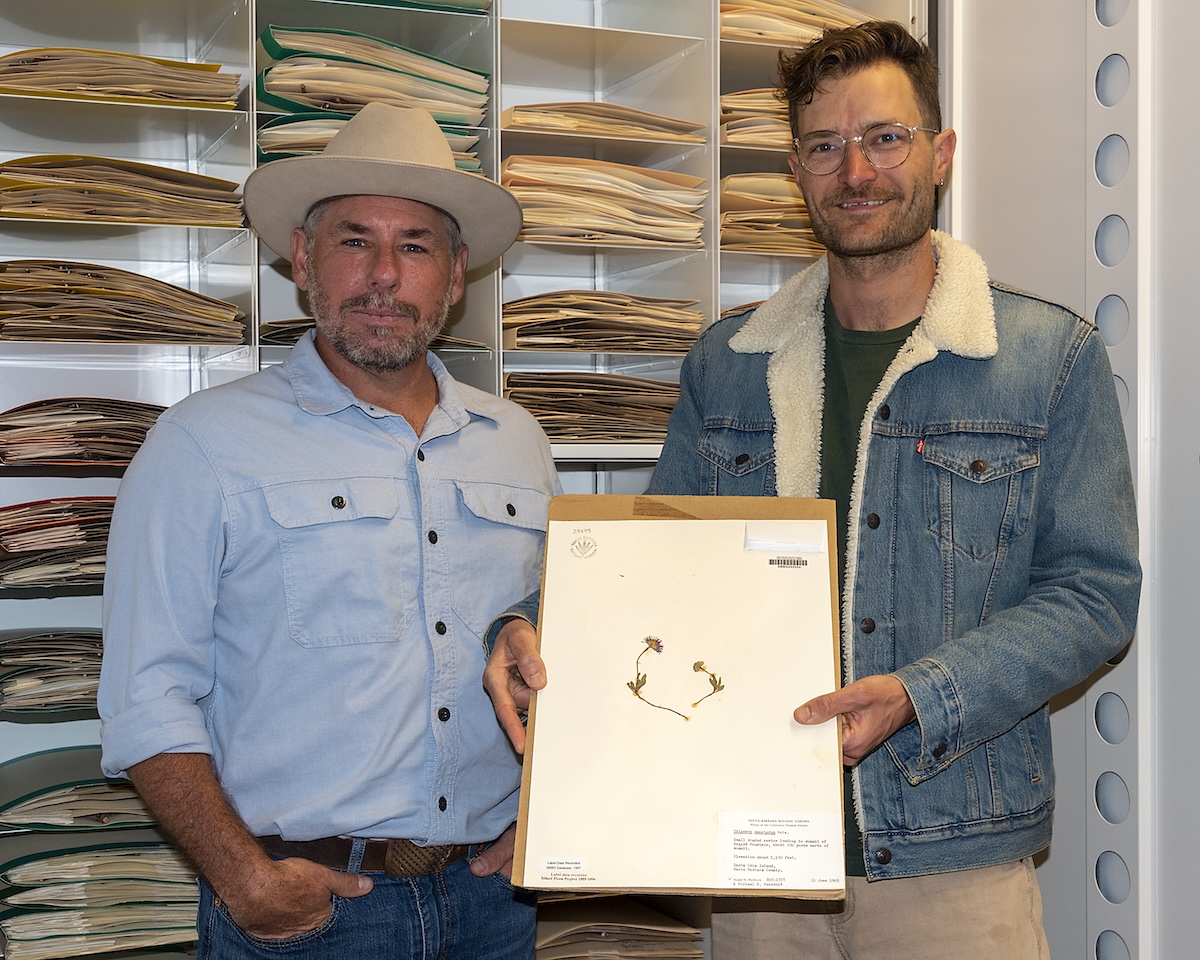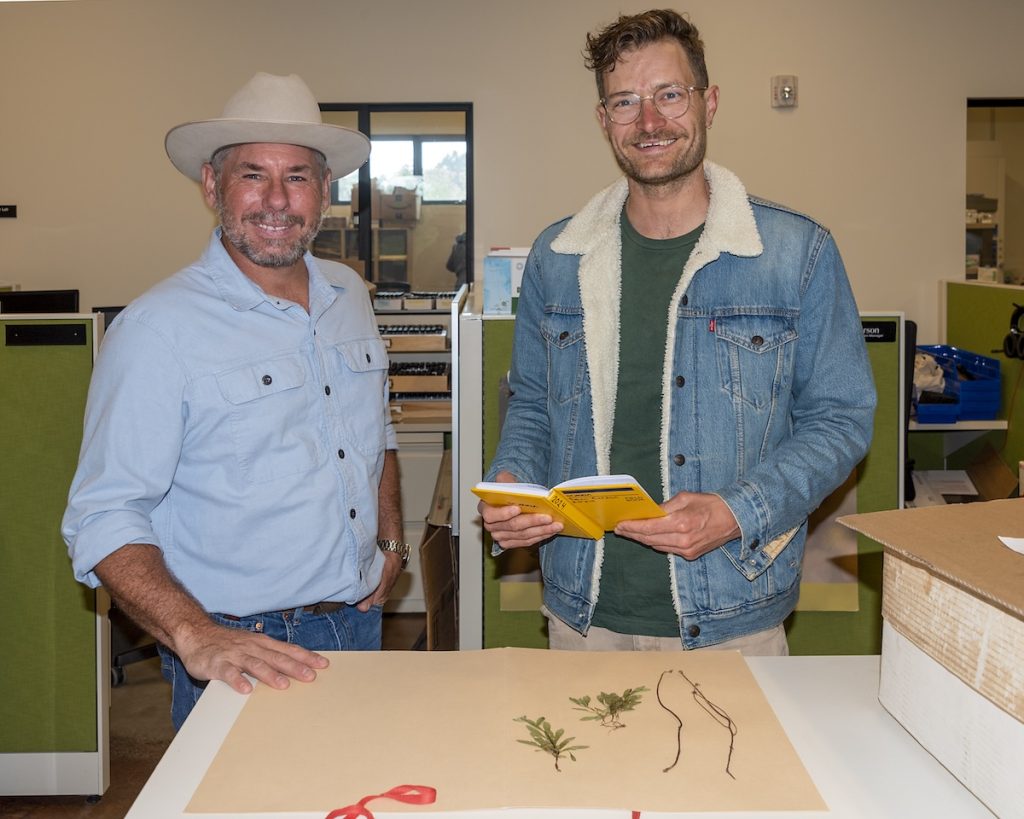[Re]-Discovery of the Rare Saints’ Daisy Flower on Santa Cruz Island

The Nature Conservancy contacted me about a “re-discovery” of a rare and endangered lavender daisy on Santa Cruz Island, called Saints’ Daisy, last seen there 59 years ago.
The discovery was by Santa Barbara Botanic Garden’s [SBBG] Rare Plant Field Program Manager Sean Carson, who, with his colleague John Knapp, Senior Island Scientist for The Nature Conservancy [TNC], were on a mission to do just that. Carson works to conserve California’s rare and endangered flora. Knapp works on developing and refining cost-effective conservation strategies and methodologies to better manage ecosystems and stop extinction.
In addition to finding the Saints’ Daisy, the team also found new populations of two rare and fragile Santa Cruz Island endemic and federally endangered plants, the Santa Cruz Island bush-mallow and the Island barberry. There are only six known and recorded individual bush-mallows and twelve individual Island barberry in the world.
Carson, Knapp, and I met this week at the SB Botanic Garden’s botanist lab. We talked about the discovery, why it’s important, and to remind everyone, from scientists to kids, to safeguard these flowers for future generations. They pitched how important funding is so their work can continue in these efforts for generations to come.
MJ.What were you both doing when you came across the Saints’ Daisy?
John Knapp [JK]. We had a number of species we were targeted to look for. We had six on the team and fanned out to find it. Only Sean and Steve Junak had seen it before. Junak retired from SBBG and is their research associate and botanist emeritus, and active researcher and expert on the flora of the islands of California and Baja California, Mexico. This was our 10th year at TNC looking for approximately 15 plus species we thought were extricated, locally extinct, from the island. This was the first one we found in a decade, some haven’t been seen since 1888, and the Saints’ Daisy since 1965.

Sean Carson [SC]. I had the mental image and its habitat in my head. It’s identified by a small basil rosette, maybe a few inches off the ground, with linear to spoon shaped leaves, and long wispy hairs on the edges of the leaves and stem. I crawled down on the ground to get a closer look to confirm it. The ones I spotted were not flowering yet but had shooting flower stocks. We saw the flower in a bud and knew it had to be an aster, it had a shooting peduncle, and saw some lavender colors. We saw old flowering stocks and old seeds on the ground. We called out to everyone – we found it, the crown jewel. Everyone came over and we took selfies with it!
MJ. Why is this discovery important?
SC. This find is important because it shows that the island is making a recovery.
It highlights re-finding plants that haven’t been seen since 1965, and the collaboration of the SBBD and TNC combining our knowledge to find plants like it. Now we know it’s here, we survey it further to monitor it and really protect it in a world where there are lots of dangers to it.
JK. The fact that we found another lost plant makes it so that the island is more resilient to disturbances like climate change. The TNC manages 76% of the island, 24% is the Park Service, and work jointly as a single ecological unit. We are trying to get an understanding of what we lost. There are 15-20 plants nobody has seen for over 60 years. We also look for our Federally Endangered and Threatened plants. We do this to figure out if they are not here, where they are and reintroduce them back to the islands.
MJ. What is your plant sampling rule?
SC. We have a 1 in 10 Rule, if there are ten plants, you can sample one or part of one. As botanists we need to do the research, to take samples to inform science, but we also think about the health of the plant’s population. We can do a lot with a small piece.
JK. In the last century, there was an issue of over collection, especially with wildlife. We work with the SBBG and share information, so I did not take any samples.
MJ. How can people identify if they found one?
JK. These are endangered species. Do not take a specimen, cut the flowers, or pull them out of the ground. We strongly recommend people take a photo and upload it to the phone app, iNaturalist, with the GPS. Botanists check the app and will let you know what it is.
411:
https://sbbotanicgarden.org/team/sean-carson/
www.nature.org/en-us/
www.inaturalist.org/







You must be logged in to post a comment.